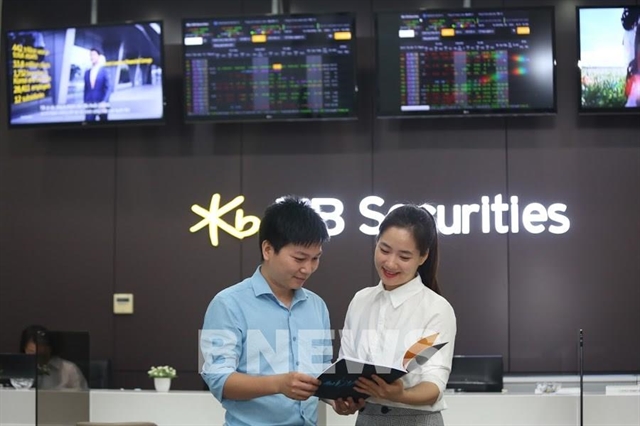 Economy
Economy

 |
| The đồng’s depreciation against the USD has moderated to 1 - 2 per cent, fostering market and investor confidence. VNA/VNS Photo |
HÀ NỘI — As central banks worldwide reduce interest rates, Việt Nam gains more leeway to maintain a loose monetary policy, potentially creating room for further rate cuts that could positively impact the stock market.
After the US Federal Reserve's 0.5 per cent rate cut in mid-September, other central banks have followed suit. On September 25, the People's Bank of China (PBoC) cut its medium-term lending facility (MLF) rate for commercial banks from 2.3 percent to 2 per cent.
Indonesia's central bank (BI) cut its benchmark rate by 0.25 per cent to 6 per cent on September 18, and announced plans to lower rates further if needed.
Likewise, the Philippine central bank (BSP) reduced its rate by 0.25 per cent to 6.25 per cent.
In Việt Nam, the State Bank of Việt Nam (SBV) pre-emptively reduced rates, such as treasury bill rates and rates on collateralised securities open-market operations (OMO).
On August 5, these rates were lowered by 0.2 per cent to 4.25 per cent annually. Then by August 20, the Treasury bill rates further dropped to 4.2 per cent per year and by September 16, the rates on OMO were down to 4 per cent per year.
However, the market anticipates further policy rate cuts, such as lowering the cap on deposits under six months, refinancing rates and discount rates, which have been held steady since June 19, 2023.
Analysts suggested that reducing these rates could counteract the rise in deposit interest rates observed since early the second quarter of this year.
Amid expectations of a more accommodating policy to support economic growth and the strengthening of the Vietnamese đồng since the third quarter (Q3), the SBV has more room to consider further rate cuts without significant exchange rate concerns.
Alternative approaches
Some experts, however, question the likelihood of further SBV rate cuts in the near term.
According to Dr. Nguyễn Trí Hiếu, a financial expert, inflation risks, exacerbated by recent floods, could limit the SBV's flexibility. Despite a stabilised USD/VNĐ exchange rate, rising gold prices present an additional variable impacting bank deposit channels.
UOB Bank stated that the SBV may prioritise targeted support measures for individuals and businesses affected by the floods rather than broad rate cuts.
Meanwhile, VinaCapital analysts believed the Government has other tools, such as increased infrastructure spending and real estate sector support, that could effectively stimulate the economy without further rate cuts.
At the Q3 press conference on October 17, SBV Deputy Governor Đào Minh Tú said that, to ensure banking system liquidity and maintain credit availability, the SBV will continue its stable interest rate and exchange rate policies while remaining open to adjusting policy rates as needed.
Tú highlighted the SBV's proactive exchange rate management, which has absorbed external shocks and stabilised the foreign exchange market, meeting all foreign currency demands in the economy. Notably, the đồng’s depreciation against the USD has moderated to 1 - 2 per cent, fostering market and investor confidence.
 |
| Investors on a trading floor of a securities company. Photo bnews.vn |
Positive outlook for stock market
HSBC forecast that the Fed may implement two additional 0.25 per cent rate cuts in November and December due to easing US inflation. This development is expected to boost investor sentiment in Việt Nam’s stock market, which is highly sensitive to interest rate changes. Lower borrowing costs would enable companies to reduce financial expenses, support expansion and improve profitability, thus strengthening stock valuations.
Dragon Capital noted that the Fed's rate-cutting direction is advantageous for investment channels like stocks. Lower corporate borrowing costs create favourable conditions for growth, increasing company valuations and enhancing the stock market's appeal.
The Fed’s rate cuts have also benefited Việt Nam’s monetary policy by easing foreign exchange pressure and promoting stable borrowing costs in Việt Nam. Consequently, credit expansion and public investment disbursements may accelerate, aligning with the government’s growth objectives.
Data shows that 40 per cent of listed companies on the Hồ Chí Minh Stock Exchange (HoSE) achieved over 20 per cent growth in recent quarters, with nearly half reporting double-digit quarterly growth.
Further supporting market sentiment, the Ministry of Finance's Circular 68/2024/TT-BTC, effective November 2, revises margin requirements for foreign institutional investors, paving the way for Việt Nam’s potential upgrade to FTSE market status.
Chairman of Dragon Capital, Dominic Scriven, anticipated a recovery in corporate profits, projecting an 18 per cent growth rate for the top 80 listed firms by market capitalisation in 2024.
Meanwhile, Dr Nguyễn Hữu Huân from the HCM City University of Economics saw the Fed’s ongoing rate cuts as a stabilising factor for the Vietnamese đồng, reducing the need for SBV to raise rates.
This rate-cut trajectory grants SBV flexibility to support liquidity and maintain low interbank rates, fostering stable deposit and lending rates.
With rising stock market returns and reduced corporate borrowing costs, SBV’s policy direction is expected to positively impact business performance and stock market growth. — VNS